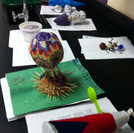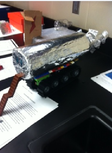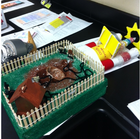Warm-up:
1._____________boundary is when two plates move away from each other
2.Convergent boundary is formed when ___________________________________
3.Faults are created by __________________.
Classwork:
Lecture (Plate Tectonics Section 3: See attached PowerPoint)-Fill in the blanks on the follow along sheet.
Group work. Finish charts and start on "tectonic plates" illustrations.
Homework: finish "tectonic plates" illustrations. Underline or highlight definition, and illustrate plate movement on box. Label which plate is which, draw arrows to show movements. (4 parts per section, 6 sections total).
Warm-up:
1.The two types of plates are called _________ and _____________.
2.Theory of Continental Drift states that: ____________________________________________________________
3.Three types of plate movements are convergent, ___________ and ____________.
Classwork:
Lecture part 2 (sea floor spreading)---please see attachment for Section 2 of lecture notes
Group work (finish tectonic plates chart)
*start on "plate boundaries" illustrations
Homework: bring book (if you haven't already)

| plate_tectonics_part_2.pptx |
| File Size: | 196 kb |
| File Type: | pptx |
Download File
Warm-up: Friday Reflection (Write to Parents)
Think back to the last few weeks of school. Name 3 scientific concepts or ideas that you have learned that you did not know before. If your parents could have joined you, which science lesson do you wish they could have learned with you? Why?
*Anything else going on in school (other classes) that you would like to share with your parents?
*Don’t forget to get your warm-up signed. Remember, if your parents reply, you get +1 for warm-up. WRITE THIS IN YOUR AGENDA.
Classwork:
Theory of Continental Drift & Movement of Tectonic Plates Lecture [see attached for section 1 of notes]
Group work (tectonic plates chart)
Homework: Bring textbook to class. Get warm-up signed

| plate_tectonics_part_1.pptx |
| File Size: | 525 kb |
| File Type: | pptx |
Download File
Warm-up:
The prefix “centi” means: --
The prefix “kilo” means:
Convert .78km to centimeters.
Classwork: (see file below for handout)
Video -2 min video about plates
Lecture-Intro to tectonic plates
Group work- boundaries chart
Homework: bring book to class on Monday

| plate_tectonics__boundaries.docx |
| File Size: | 20 kb |
| File Type: | docx |
Download File
Warm-up:
1._____________is the thickest layer of the physical model and ____________is the thickest layer of the compound model.
2.___________model is also known as chemical model because it shows the chemical composition (what it is made up of)
3.SI units that can be used to measure volume are:
Classwork:
pre-assessment
BrainPop video
Four-corners game
Homework: bring book to class on Monday
Warm-up: Presentation day. Make a "exit slip" on a separate sheet of paper
Classwork: Presentation
3D model [present how different parts or components of your model helps you travel through each layer]
Brochure [present what you can expect to see when traveling to the layer of your choosing- how much does it cost, any fun things to do while you are there? etc]
News Article [what ground-breaking event made the headline? Tell us a bit about this awesome invention]
Homework: No homework. Great job on your projects, everyone! =)
Student Work Sample (see below): More to come throughout the week!
Warm-up:
1.Define the following:
Control:
Constant:
2. The prefix “milli” has a value of _________.
3. The prefix “kilo” has a value of __________.
Classwork: work on projects
submit drafts to Ms. Kwon for proof-reading
Homework: project due tomorrow! Must submit write up, rubric & model; rubric & newspaper article or brochure
The distance from the surface of the earth to the center of the earth is approximately 6,380km.
The approximate thickness of each layer and temperature is as follows:
Lithosphere- 15km-200 km; 0-1000'C
Asthenosphere- 250 km; 1,000-2,000'C
Mesosphere-2,550 km; 2,000'C-3,000'C
Outer Core-2,200 km; 3,000'C-4,000'C
Inner Core-1,230 km; 4,000-5,300'C
To calculate how long it will take for your machine to reach the center of the earth, first decide how fast your machine will travel. Then, covert it to km and then divide the whole distance (6,380km) by your speed in km/hr. See example below:
1. I estimate my machine will travel 100mph. 100m/hr in km/hr is: 100m/hr X 1.61km/m= 161km/hr
2. Total distance/my speed in km/hr is: 6,380km/161km/hr= 39.6 hrs.
3. 39.6 hours= 1 day 15 hours and 36 minutes.
Warm-up: —Friday Reflection
Write to your teacher (Dear Ms. Kwon,)
What did you learn in this unit that you did not know before? What did you find interesting? What do you wish you could learn more about? Tell me a bit about your project that you are working on.
(at least 6 sentences for the prompt above)
Classwork: work on project
Homework: work on project. Bring materials to finish project on Monday.
See this weekend's post for additional assistance with project
Warm-up:
1. The part of the Earth on which the tectonic plates move is the ______________.
2. The layer that makes up the tectonic plate is called ____________.
3. The thickest layer of the physical model is ______.
*Get out the articles (your homework from last night)
*Write homework in agenda
Classwork:
Group discussion- articles
Class discussion-articles.
"Is Stevenson's probe realistic? Why/why not?"
"What if we really could drill into the center of the Earth?"
Introduce "Journey to the Center of the Earth" mini-project
Homework:
start working on the "mini-project": Create a machine, brochure, or newspaper article
MINI-PROJECT DUE TUESDAY, SEPT. 11




 RSS Feed
RSS Feed